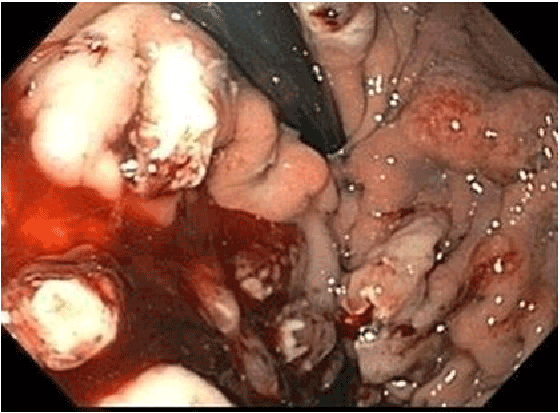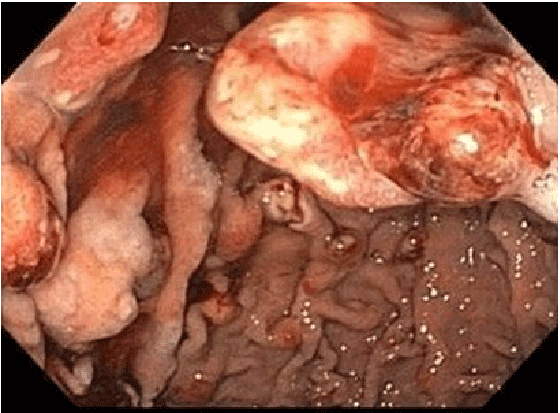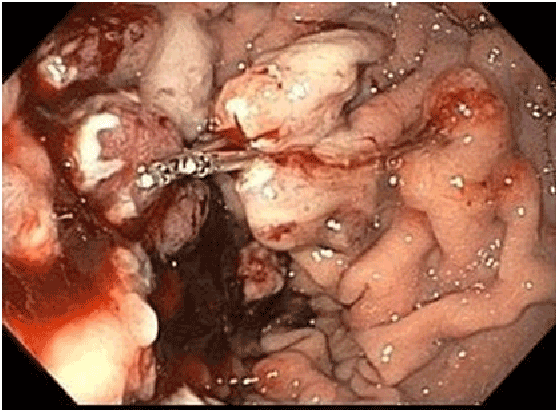
Figure 1: Gross blood loss from ulcerated gastric hyperplastic polyps

Patrick Chen Sangeeta Agrawal*
Department of Internal Medicine, Division of Gastroenterology, Wright State University, Dayton VA Medical Center, USA*Corresponding author: Sangeeta Agrawal, Associate Professor of Medicine, Dept. of Internal Medicine, Division of Gastroenterology, Wright State University, Dayton VA Medical Center, USA, Tel: 937-268-6511, ext 2698; Fax: 937-262-2154; E-mail: Sangeeta.Agrawal@va.gov
Hyperplastic polyps (HPPs) are inflammatory proliferations of gastric foveolar cells, commonly found in the gastric antrum [1]. They are usually found incidentally during endoscopy and grossly appear as smooth, dome-shaped, or stalked polyps [1]. Histologically the polyp’s microscopic characteristics include elongation, branching, twisting and cystic dilation of the foveolae and chronically inflamed lamina propria [1]. Generally patients with HPPs are asymptomatic, but some present with abdominal discomfort, iron deficiency anemia, or gastric outlet obstruction [2]. HPPs are associated with atrophic gastritis and gastric atrophy as the hypothesized pathogenesis is due to exaggerated regeneration to mucosal injury [3]. Helicobacter pylori has a known association with HPPs [1]. We present a rare case of hematemesis secondary to ulcerating hyperplastic gastric polyps.
A 42-year-old male with history of alcohol abuse, and prior HPPs presented with hematemesis. Hemoglobin (hgb) was found to be 9.0 mg/dl. An esophagogastroduodenoscopy (EGD) performed 3 months earlier had revealed a 2 cm ulcerated pedunculated gastric polyp that was removed, and multiple additional friable polyps. Pathology revealed hyperplastic polyps with no evidence of H Pylori or autoimmune atrophic gastritis. Hgb levels remained stable without any requirements for a blood transfusion and therefore no repeat EGD was done during this admission.
The patient was readmitted 8 months later with complaints of fatigue and found to have hgb of 6 mg/dl. EGD was performed which revealed fifteen large friable ulcerated pedunculated gastric polyps ranging from 1 to 5 cm in size which were actively oozing blood (Figures 1 and 2). Hemostasis was achieved by placement of endoclips (Figure 3).
Patients diagnosed with HPPs are typically asymptomatic and thus most HPPs are found incidentally during endoscopy. Excluding anticoagulation or anti platelet treatment, HPPs can cause occult gastrointestinal bleeding from erosions of the polyp’s epithelium, rather than overt gastrointestinal bleed. The significance of gastric HPPs in patients with iron deficiency anemia has not been well studied in the literature [3]. Two case studies with patients diagnosed with anemia due to HPPs showed improvement of anemia after polypectomy [2,4]. Another rare complication from large pedunculated HPPs is obstruction from polyps in the antrum prolapsing into the pylorus [5].
The uniqueness of our case arises from the rare presentation of hematemesis secondary to HPPs. There have been two other documented cases of hematemesis from HPPs found in the literature search. One case was of a 10 month old male and the other case involved a 32 year old male with history of colonic adenoma [6,7]. None of these patients had H. pylori infection, which is most commonly associated with HPPs. Another risk factor of HPPs is hypergastrinemia [8]. Our patient had been on omeprazole 40 mg capsule twice per day for many years, which induces hypergastrinemia. However, the relationship between persistent hypergastrinemia and HPP formation is not yet clear [7]. There have been 3 studies involving patients with HPPs and long term proton pump inhibitor use that support the association between HPP and hypergastrinemia [9-11].

Figure 1: Gross blood loss from ulcerated gastric hyperplastic polyps

Figure 2: Large pedunculated gastric hyper plastic polyp 5 cm in longest diameter

Figure 3: Endoclip placement for hemostasis
We recommend that physicians become aware of large HPPs as rare etiology for acute GI bleed and these patients should undergo removal of large ulcerated HPPs.
Download Provisional PDF Here
Aritcle Type: Case Report
Citation: Chen P, Agrawal S (2015) Hyperplastic Gastric Polyp – An Unusual Cause of Hematemesis. J Gastric Disord Ther 1 (2): doi http://dx.doi. org/10.16966/2381-8689.109
Copyright:© 2015 Chen P, et al. This is an open-access article distributed under the terms of the Creative Commons Attribution License, which permits unrestricted use, distribution, and reproduction in any medium, provided the original author and source are credited.
Publication history:
All Sci Forschen Journals are Open Access